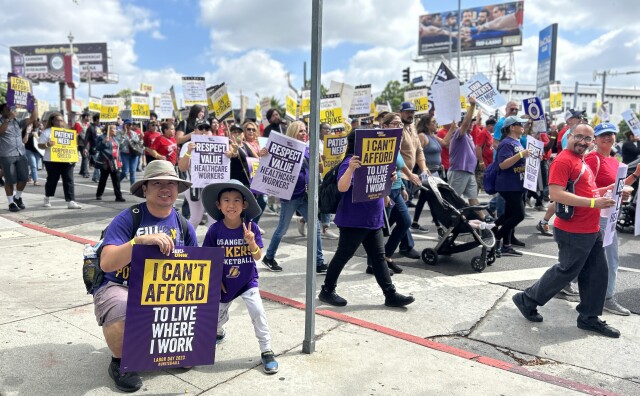Racism 101 Asked And Answered: Why Does Talking About Race In America Focus So Much On Skin Color, Usually Blacks And Whites?

-
We created Racism 101 to help our audience facilitate their own thought-provoking talks around race, with a conversation "starter kit," and extensive anti-racism resource guides to inform and educate. To field these questions, we assembled a panel of Angelenos willing to answer so folks didn't have to ask their friends, or even strangers.
We've solicited questions from our audience — awkward, tough-to-ask, even silly questions — that they've perhaps wanted to ask people unlike themselves but have been too shy, embarrassed or afraid to ask.
WHAT'S ON YOUR MIND?
Q: "Why do Americans focus on calling people by a color, 'I'm Black,' or 'I'm white,' like Crayolas? People from Colombia just say they are Colombianos."
A 9-year-old girl from Loudon County, Virginia might be able to answer this question. In February, third-grader Bellen Woodard asked one of her classmates for the "skin-color" crayon. As the Washington Post reported, "[Bellen] knew that meant the peach-colored crayon. She also knew her skin wasn't the color of peaches. She is the only black girl in her grade."
Woodard recounted the situation to her mother later. In her child mind, she explained that she felt "disincluded." The "More than Peach" project was born. Woodard donates art kits to schoolchildren and classrooms which include a drawing pad, a personal postcard from her, a standard box of crayons (or colored pencils), and a special box of Crayola's Multicultural crayons (or colored pencils) which include hues like burnt sienna, mahogany, peach and sepia to represent diverse shades of racial/ethnic skin tones.

Have you ever heard of the "Doll Tests?" They were experiments designed and conducted by Drs. Kenneth and Mamie Clark in the 1940s to test the psychological effects of segregation on Black children. In a 1985 interview with PBS, Clark said, "We did it to communicate to our colleagues in psychology the influence of race and color and status on the self-esteem of children."
The Doll Tests studied 253 Black children ages 3-7, 134 who attended segregated nursery schools in Arkansas and 119 who went to integrated schools in Massachusetts. They were all shown two dolls with white skin and yellow hair and two dolls with brown skin and black hair. They were asked which doll's race they identified with most and which they preferred to play with.

Most of the Black children preferred a white doll, assigning it positive traits and saw the brown-skinned dolls as "bad." One boy in rural Arkansas, when he was asked which doll was most like him, smiled and pointed to the brown doll, according to an account by the NAACP Legal Defense and Educational Fund. "That's a n*gger. I'm a n*gger."
The Supreme Court cited Clark's work in its landmark 1954 Brown v. Board of Education decision which integrated schools...under the law at least.
HOW OUR RACISM 101 PANELISTS RESPONDED
O'Neil was born in Jamaica, has lived in L.A. for 20 years. He's the father to three kids, including a biracial daughter who is Black and white.
"Americans focus on calling people of African descent by a color because it's a systemic result of a negative label that was meant to describe the slaves. We didn't decide to call ourselves "Black." Slavers did. I have yet to meet one "Black" person. It's as woven into our society as any past racial transgression from the past, and to face it, means to look upon an ugly history, that most would rather ignore. 'Lets ignore it and maybe it will go away one day.'"
Carene describes herself as a proud Black Armenian Angelena. As an artist, she says that her multifaceted identity informs her work. She breaks down how America's legacy of enslavement of Blacks and white supremacy pushes the conversation about Blacks and whites to the forefront, but doesn't ignore other groups.
Pat, a native Angeleno raised in East L.A., contemplates how class and colonialism play a role in this binary way of thinking:
"We tend to call people by their color because it has such historical and current meaning. The United States has such a deep history of racism and that is expressed in many ways. It is somewhat similar to classism in Colombia, where there is similar, deeply entrenched colonialism. We too are deeply classist, but it tends to get buried under the racism."
-
The project will rename most of the terminals and all of the gates with the goal of world-class signage that leans into psychology.
-
After San Gabriel's city council rejected the proposal as "too narrow", one city councilmember argued the entire DEI commission, created in the aftermath of George Floyd's murder, had "run its course."
-
A medical industry challenge to a $25 minimum wage ordinance in one Southern California city suggests health workers statewide could face layoffs and reductions in hours and benefits under a state law set to begin phasing in in June. Some experts are skeptical, however, that it will have such effects.
-
Sandhill cranes are returning to the Lake Tahoe basin after a century long hiatus in what many say is a conservation success story.
-
The Dodgers fired Mizuhara in March after Ohtani's lawyers accused him of stealing millions of dollars from the baseball player to place bets with an Orange County-based bookie.
-
Jackie’s partner, Shadow, refuses to abandon their unviable eggs, despite her attempts to nudge him along.








